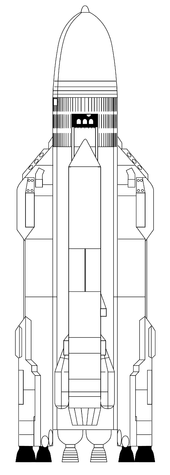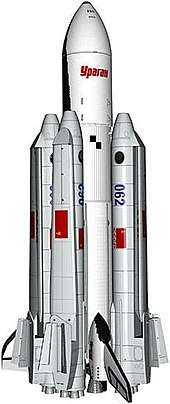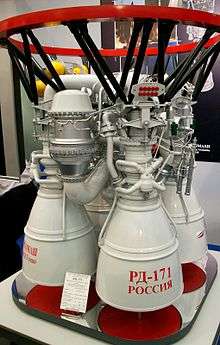Energia
Energia (Russian: Энергия, Energiya, "Energy") (GRAU 11K25) was a Soviet rocket that was designed by NPO Energia to serve as a heavy-lift partially recoverable launch system for a variety of payloads including the Buran spacecraft. Control system main developer enterprise was the Khartron NPO "Electropribor".[3][4] The Energia used four strap-on boosters each powered by a four-chamber RD-170 engine burning kerosene/LOX, and a central core stage with 4 one-chamber RD-0120 (11D122) engines fueled by liquid hydrogen/LOX.[5]
 | |
| Function | Human-rated multi-purpose super heavy-lift launch vehicle |
|---|---|
| Manufacturer | NPO "Energia" |
| Country of origin | Soviet Union |
| Size | |
| Height | 58.765 m (192.80 ft) [1] |
| Diameter | 17.65 m (57.9 ft) 7.75 m (25.4 ft) Core stage[1] |
| Mass | 2,400,000 kg (5,300,000 lb) |
| Stages | 2 |
| Capacity | |
| Payload to LEO | 100,000 kg (220,000 lb)[2](Required upper stage or payload to perform final orbital insertion) |
| Payload to GSO | 20,000 kg (44,000 lb) (proposed; never flown)[2] |
| Launch history | |
| Status | Retired |
| Launch sites | Baikonur |
| Total launches | 2 |
| Successes | 2 |
| Failures | 0 |
| First flight | 15 May 1987 |
| Last flight | 15 November 1988 |
| Boosters – Zenit | |
| No. boosters | 4 |
| Length | 39.46 m (129.5 ft) [1] |
| Diameter | 3.92 m (12.9 ft) [1] |
| Engines | 1 RD-170 (4 nozzles) |
| Thrust | 29,000 kN (6,500,000 lbf) sea level 32,000 kN (7,200,000 lbf) vacuum |
| Specific impulse | 309 s at sea level 338 s in vacuum |
| Burn time | 156 s |
| Fuel | RP-1/LOX |
| Core stage | |
| Length | 58.765 m (192.80 ft) [1] |
| Diameter | 7.75 m (25.4 ft) [1] |
| Engines | 4 RD-0120 |
| Thrust | 5,800 kN (1,300,000 lbf) sea level 7,500 kN (1,700,000 lbf) vacuum |
| Specific impulse | 359 s at sea level 454 s in vacuum |
| Burn time | 480-500 s |
| Fuel | LH2/LOX |
The launch system had two functionally different operational variants: Energia-Polyus, the initial test configuration, in which the Polyus system was used as a final stage to put the payload into orbit, and Energia-Buran,[6] in which the Buran spacecraft was the payload and the source of the orbit insertion impulse.
The rocket had the capacity to place about 100 tonnes in Low Earth orbit, up to 20 tonnes to geostationary orbit and up to 32 tonnes via translunar trajectory into lunar orbit.[2]
The rocket made just two flights to orbit, one each in 1987 and 1988.[7][6]
History
Launches
| Flight number | Date (UTC) | Launch site | Serial no. | Payload | Orbit at payload separation | Remarks |
|---|---|---|---|---|---|---|
| 1 | 15 May 1987 17:30:00 |
Baikonur Cosmodrome Site 250 | 6SL[8] | Polyus | -15 x 155 km x 64.61°[9] | Spacecraft software error led to orbit insertion burn performed in incorrect attitude and payload re-entered atmosphere before completing first orbit.[10] |
| 2 | 15 November 1988 03:00:01 |
Baikonur Cosmodrome Site 110/37 | 1L[8] | Buran | -11.2 x 154.2 km x 51.64°[11] | First and only flight of Buran. The spacecraft orbited Earth twice before de-orbiting and landed at Baikonur at 06:24 UTC. |
Development
Work on the Energia/Buran system began in 1976 after the decision was made to cancel the unsuccessful N1 rocket. The facilities and infrastructure built for the N1 were reused for Energia (notably the huge horizontal assembly building), just as NASA reused infrastructure designed for the Saturn V in the Space Shuttle program. Energia also replaced the "Vulkan" concept, which was a design based on the Proton (rocket family) and using the same hypergolic propellants, but much larger and more powerful. The "Vulkan" designation was later given to a variation of the Energia which has eight boosters and multiple stages.

The Energia was designed to launch the Soviet "Buran" reusable shuttle,[6] and for that reason was designed to carry its payload mounted on the side of the stack, rather than on the top, as is done with other launch vehicles. Design of the Energia-Buran system assumed that the booster could be used without the Buran orbiter, as a heavy-lift cargo launch vehicle; this configuration was originally given the name "Buran-T".[7] This configuration required the addition of an upper stage to perform the final orbital insertion.[7] The first launch of the Energia was in the configuration of a heavy launch vehicle, with the large Polyus military satellite as a payload, however Polyus failed to correctly perform the orbital insertion.
Due to the termination of the Buran programme the Energia program was concluded after only two launches, and further the payload on the first launch didn't perform the final boost properly. The legacy of Energia/Buran project manifests itself most visibly in form of the RD-170 family of rocket engines, and the Zenit launcher, with the first stage roughly the same as one of the Energia first-stage boosters.
First launch (Energia-Polyus)
The Energia was first test-launched on 15 May 1987, with the Polyus spacecraft as the payload. A FGB ("Functional Cargo Block") engine section originally built as a cancelled Mir module was incorporated into the upper stage used to eject the payload into orbit, similarly to Buran and the US Space Shuttle performing the final orbital insertion, since the planned "Buran-T" upper stage had not yet progressed beyond the planning stage.[7] The intended orbit was altitude 280 km (170 mi), inclination 64.6°.[12]
The Soviets had originally announced that the launch was a successful sub-orbital test of the new Energia booster with a dummy payload, but some time later it was revealed that the flight had, in fact, been intended to orbit the Polyus. The two stages of the Energia launcher functioned as designed, but due to a software error in its attitude control system, Polyus' orbital insertion motor failed to inject the payload into orbit. Instead, the Polyus reentered the atmosphere over the Pacific Ocean.[13]
Second launch (Energia-Buran)
_086.jpg)
The second flight, and the first one where payload successfully reached orbit, was launched on 15 November 1988. This mission launched the uncrewed Soviet Shuttle vehicle, Buran. At apogee, the Buran spacecraft made a 66.7 m/s burn to reach a final orbit of 251 km x 263 km.[6][14]
Discontinuation
Production of Energia rockets ended with the fall of the Soviet Union and the end of the Buran shuttle project. Ever since, there have been persistent rumors of the renewal of production, but given the current political realities, that is highly unlikely. While the Energia is no longer in production, the Zenit boosters are still in production and in use. The four strap-on liquid-fuel boosters, which burned kerosene and liquid oxygen, were the basis of the Zenit rocket which used the same engines. The engine is the four combustion chamber RD-170. Its derivative, the RD-171, is still used on the Zenit rocket. A half-sized derivative of the engine, the two-chamber RD-180, powers Lockheed Martin's Atlas V rocket, while the single-chamber derivative, the RD-191, has been used to launch the Korean Naro-1 (as a reduced-thrust variant named the RD-151) and the Russian Angara rocket. The RD-181, based on the RD-191, is used on the Antares rocket.[15]
Revival
In August 2016, plans were announced to develop a super heavy-lift launch vehicle from existing Energia components instead of pushing the less-powerful Angara A5V project.[16][17] This would allow Russia to launch missions towards establishing a permanent Moon base with simpler logistics, launching just one or two 80–160-ton super-heavy rockets instead of four 40-ton Angara A5Vs implying quick-sequence launches and multiple in-orbit rendezvous.[16][18]
Variants

Three major design variants were conceptualized after the original configuration, each with vastly different payloads.
Energia M
The Energia M was an early-1990s design configuration, and the smallest of the three. The number of Zenit boosters was reduced from four to two, and instead of four RD-0120 engines in the core, it was to have had only one. It was designed to replace the Proton rocket, but lost a 1993 competition to the Angara rocket.[19]
Energia II (Uragan)
Energia II, named Uragan (Russian: Ураган, Hurricane), was a rocket design proposed to be fully reusable with the capability to land on a conventional airfield. Unlike the Energia-Buran, which was planned to be semi-reusable (like the U.S. Space Shuttle), the Uragan concept was to have allowed the complete recovery of all Buran/Energia elements, like the original, totally reusable Orbiter/Booster concept of the U.S. Shuttle.[20] The Energia II core as proposed would be capable of re-entering and gliding to a landing.
Vulkan-Hercules
The final never-built design concept was also the largest. With eight Zenit booster rockets and an Energia-M core as the upper stage, the "Vulkan" (which was the same name of another Soviet heavy lift rocket that was cancelled years earlier) or "Hercules" (which is the same name designated to the N-1 rockets) configuration was initially projected to launch up to 175 tonnes into orbit.
The development of rocket-carrier "Vulcan" and the refurbishment of the "Energia" launch pad for its launches was in progress in 1990-1993. But later on the work on this project was cancelled due to lack of funds and the collapse of the Soviet Union.[21]
See also
- Comparison of orbital launchers families
- Comparison of orbital launch systems
References
- Energia Characteristics
- Launch vehicle "Energia" Official Site
- Krivonosov, Khartron: Computers for rocket guidance systems
- Control systems for intercontinental ballistic missiles and launch vehicles Archived 2010-02-05 at the Wayback Machine
- Russian Space Web, Energia page. Accessed 21 September 2010
- Bart Hendrickx; Bert Vis (2007). Energiya-Buran: The Soviet Space Shuttle. Springer Science & Business Media. ISBN 978-0-387-73984-7.
- B. Hendrickx, "The Origins and Evolution of the Energiya Rocket Family," J. British Interplanetary Soc., Vol. 55, pp. 242-278 (2002).
- Lukashevich, Vadim. "Manufacturing History of the Energia Launch Vehicle". buran.ru (in Russian). Retrieved 25 January 2018.
- Lukashevich, Vadim. "The Polyus Spacecraft". buran.ru (in Russian). Retrieved 25 January 2018.
- Day, Dwayne A.; Kennedy, Robert G. III (January 2010). "Soviet Star Wars: The launch that saved the world from orbiting laser battle stations". Air & Space/Smithsonian. Retrieved 25 January 2018.
- Lukashevich, Vadim. "Timeline of the flight of Buran on 15 November 1988". buran.ru (in Russian). Retrieved 25 January 2018.
- Vassili Petrovitch, Polyus (accessed 21 September 2010)
- "Polyus". Astronautix. Retrieved September 25, 2017.
- Mark Wade, Encyclopedia Astronautics, Buran Archived 2008-12-20 at the Wayback Machine (accessed 21 September 2010)
- "First Angara rocket launched on suborbital test flight". Spaceflight Now. July 9, 2014. Retrieved July 9, 2014.
- "Russia's A5V moon mission rocket may be replaced with new super-heavy-lift vehicle". RT.com. August 22, 2016.
Energia and Roscosmos are “working on a super heavy-lift launch vehicle (SHLLV) that would use an engine that we already have, the RD-171,” Vladimir Solntsev told Izvestia newspaper. […] The proposed new SHLLV would initially have a LEO lift of 80 tons with a potential to increase the figure to 120 tons or even 160 tons, according to Solntsev.
- "Роскосмос" создаст новую сверхтяжелую ракету. Izvestia (in Russian). August 22, 2016.
- Zak, Anatoly. "Russia's New Rocket Project Might Resurrect a Soviet-Era Colossus". Popular Mechanics. Hearst Digital Media. Retrieved 24 October 2019.
- "This Immense Russian Rocket Was Abandoned For Decades". Popular Mechanics. 2015-07-06. Retrieved 2017-05-28.
- "The Space Shuttle - NASA Technical Reports Server (NTRS)" (PDF). nasa.gov. 2011.
- Godwin, Robert (2006). Russian Spacecraft. Space Pocket Reference Guides. Apogee Books. p. 59. ISBN 1-894959-39-6.
External links
| Wikimedia Commons has media related to Energia (rocket). |

